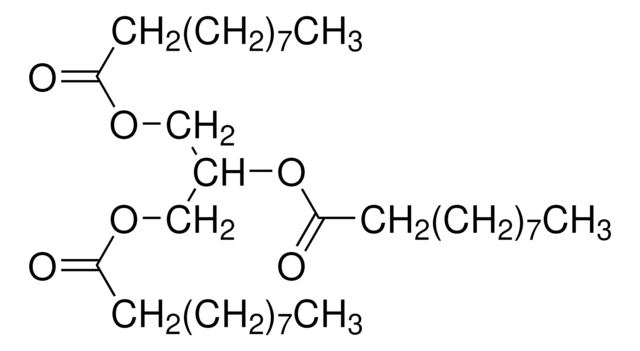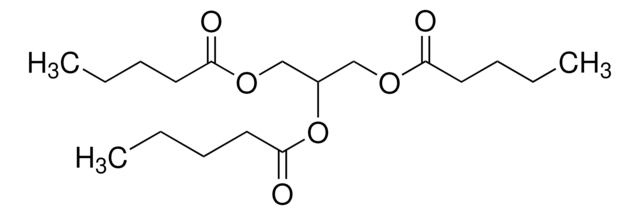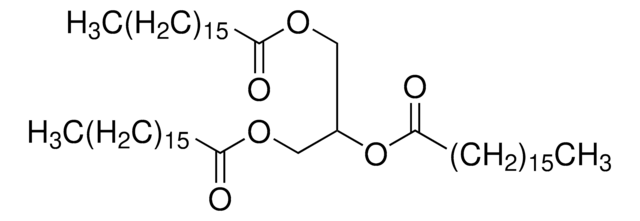Wichtige Dokumente
T5534
Glycerintriundecanoat
≥98%
Synonym(e):
1,2,3-Triundecanoylglycerin, Glycerintriundecanoat, Triundecanoin
About This Item
Empfohlene Produkte
Biologische Quelle
synthetic
Assay
≥98%
Form
solid
Funktionelle Gruppe
ester
Lipid-Typ
neutral glycerides
Versandbedingung
ambient
Lagertemp.
−20°C
SMILES String
CCCCCCCCCCC(=O)OCC(COC(=O)CCCCCCCCCC)OC(=O)CCCCCCCCCC
InChI
1S/C36H68O6/c1-4-7-10-13-16-19-22-25-28-34(37)40-31-33(42-36(39)30-27-24-21-18-15-12-9-6-3)32-41-35(38)29-26-23-20-17-14-11-8-5-2/h33H,4-32H2,1-3H3
InChIKey
MBXVIRZWSHICAV-UHFFFAOYSA-N
Suchen Sie nach ähnlichen Produkten? Aufrufen Leitfaden zum Produktvergleich
Anwendung
- als Referenzstandard in der Hochleistungsflüssigkeitschromatografie(HPLC)-Analyse zum Identifizieren der Hydrolyseprodukte und lipolytischen Aktivität in menschlicher Milch
- als interner Standard für die Gaschromatografie-Analyse für die Gesamtfettzählung
- als interner Standard für die Fettsäureanalyse in Gemüse- und Fleischproben
Signalwort
Warning
H-Sätze
Gefahreneinstufungen
Eye Irrit. 2 - Skin Irrit. 2 - STOT SE 3
Zielorgane
Respiratory system
Lagerklassenschlüssel
11 - Combustible Solids
WGK
WGK 3
Persönliche Schutzausrüstung
Eyeshields, Gloves, type ABEK (EN14387) respirator filter
Hier finden Sie alle aktuellen Versionen:
Besitzen Sie dieses Produkt bereits?
In der Dokumentenbibliothek finden Sie die Dokumentation zu den Produkten, die Sie kürzlich erworben haben.
Kunden haben sich ebenfalls angesehen
Unser Team von Wissenschaftlern verfügt über Erfahrung in allen Forschungsbereichen einschließlich Life Science, Materialwissenschaften, chemischer Synthese, Chromatographie, Analytik und vielen mehr..
Setzen Sie sich mit dem technischen Dienst in Verbindung.














